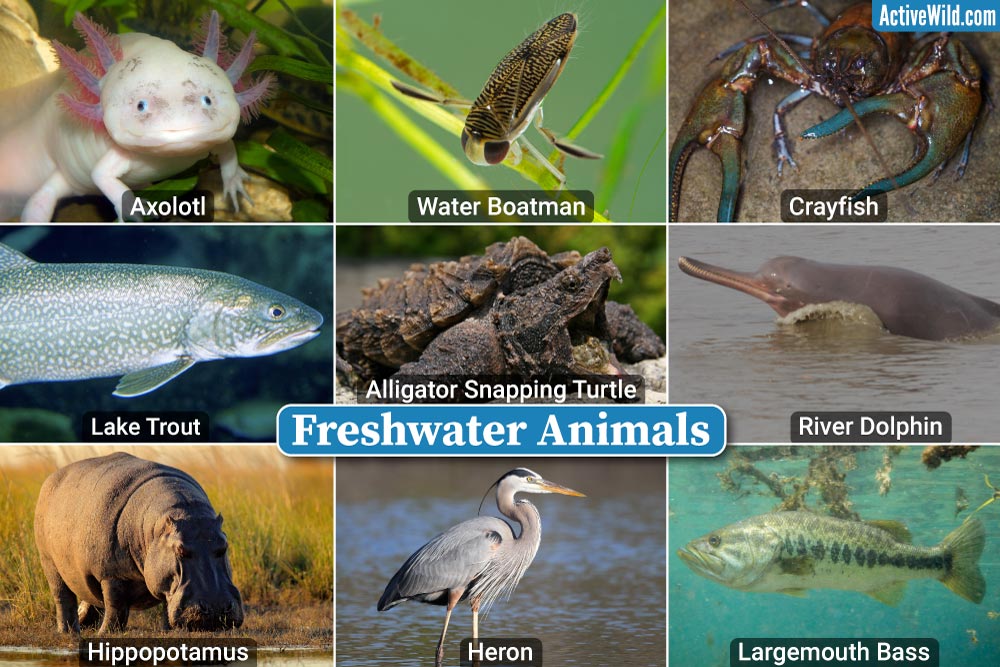Freshwater animals include mammals such as otters, river dolphins and hippos; birds such as dippers, herons and kingfishers; insects such as mayflies, water striders and dragonflies; fish such as bass, lake trout and piranhas, and amphibians such as frogs, newts and the axolotl.
On this page is a list including these and many other examples of animals that live in freshwater habitats from all around the world.
Freshwater Ecosystems
Less than 3% of Earth’s water is freshwater, and much of that is frozen in the form of polar ice caps and glaciers.
The percentage of Earth’s water able to support a wide diversity of life is far smaller – in fact, just 0.014% of all Earth’s water is freshwater in the form of rivers, lakes and swamps. (Source)
(You can find out more on these statistics on this page: The Freshwater Biome)
This tiny proportion of all water is vitally important for life on Earth. For example, 41% of all fish species are found in freshwater – despite 97% of the Earth’s water being saltwater oceans and seas.
The majority of mammals, reptiles, birds, amphibians and insects all rely on freshwater to survive.
On this page is a list of freshwater animals, all of which live in freshwater habitats such as rivers, lakes, swamps and marshes.
Scroll down to see pictures and facts on all of the animals, or use the index below to go directly to a particular animal.
Freshwater Animals
- Alligator
- Amazonian Manatee
- Axolotl
- Caiman
- Capybara
- Common Watersnake
- Crayfish
- Dipper
- Diving Beetle
- Dragonfly
- Electric Eel
- Freshwater Crab
- Freshwater Jellyfish
- Frog
- Giant Freshwater Stingray
- Green Anaconda
- Hellbender
- Heron
- Hippopotamus
- Kingfisher
- Lake Trout
- Largemouth Bass
- Mayfly
- Newt
- Northern Pike
- Otter
- Piranha
- River Dolphin
- Turtle
- Water Boatman
- Water Strider / Pond Skater
- Water Vole
You can see more freshwater animals on this page: Lake Animals
Alligator
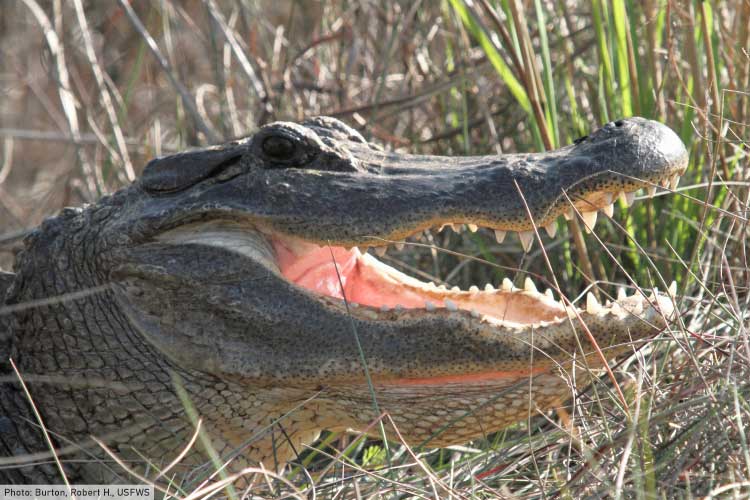

- Type of Animal: Reptile
- Family: Alligatoridae
- Where Found: North America, Asia
- Conservation Status: (American alligator) Least Concern; (Chinese alligator) Critically Endangered
There are two species of alligator: the American alligator and the Chinese alligator. Both belong to the family Alligatoridae, which is also home to caimans.
Like most crocodilians*, alligators inhabit bodies of freshwater such as lakes and rivers. Alligators are less tolerant of saltwater than crocodiles, and are therefore restricted to freshwater environments. (Very occasionally they are found in brackish waters.)
* A crocodilian is a member of the reptile order Crocodilia, which is home to crocodiles, alligators, caimans, and gharials.
The American alligator is found in the southeastern United States. Reaching up to 4.6 m / 15.1 ft in length, it is over twice the size of the Chinese alligator.
An apex predator, the American alligator preys on a wide variety of freshwater animals, ranging from fish to waterbirds.
The Chinese alligator is critically endangered, with under 100 adult individuals thought to be left in the wild. (There are more Chinese alligators in captivity than there are in the wild.)
Discover More With Active Wild
You can find out more about the American alligator on this page: American Alligator Facts
Discover more apex predators on this page: Apex Predators
Amazonian Manatee
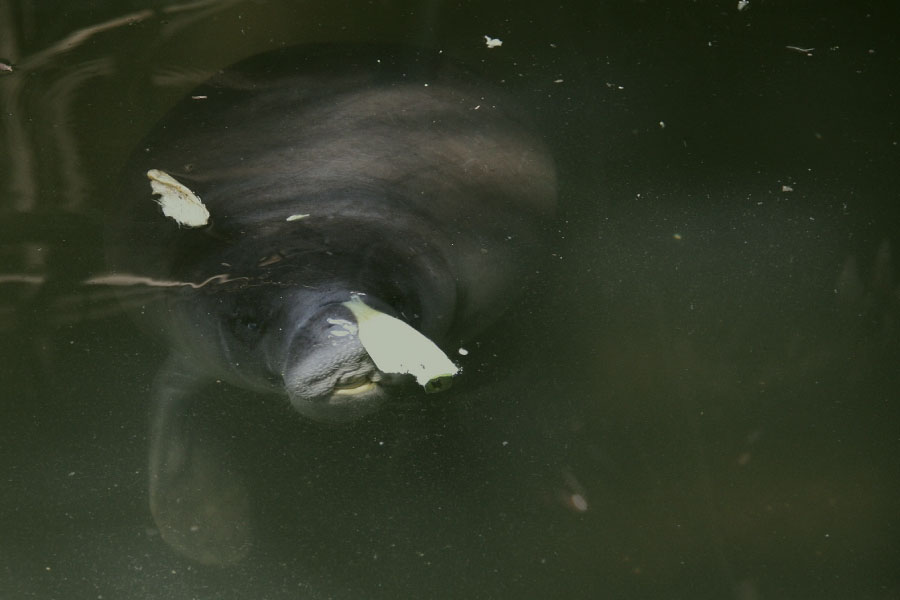

- Type of Animal: Mammal
- Family: Trichechidae
- Where Found: South America
- Scientific Name: Trichechus inunguis
- Conservation Status: Vulnerable
The Amazonian manatee is the smallest of the three manatees, and the only one to be found exclusively in freshwater habitats (the West Indian manatee and the African manatee are also found in coastal waters).
As its name suggests, the Amazonian manatee is found in South America’s Amazon Basin, and is present throughout much of the Amazon River itself.
The Amazonian manatee is herbivorous, its diet consisting of a variety of aquatic plants. It eats 8% of its body weight every day.
The main threat to this vulnerable animal is illegal hunting.
Discover More With Active Wild
You can find out more about manatees on this page: Manatee Facts
Axolotl
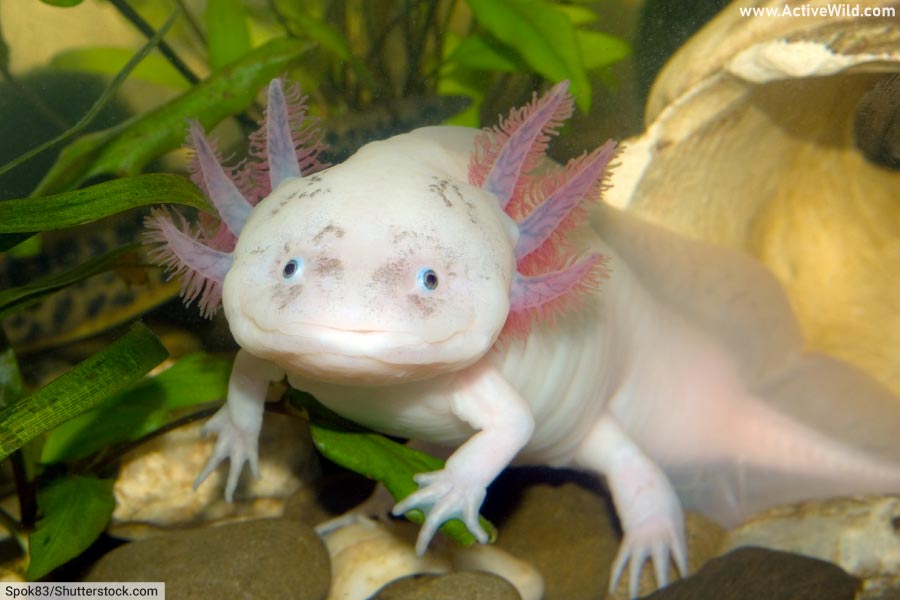

- Type of Animal: Amphibian
- Family: Ambystomatidae
- Where Found: North America
- Scientific Name: Ambystoma mexicanum
- Conservation Status: Critically Endangered
The axolotl is a critically endangered amphibian found in Mexico City.
Several of the lakes in which the species was originally found have been drained, and the species is now present only in a limited number of canals. This has led to the axolotl becoming critically endangered in the wild.
Despite being threatened with extinction in the wild, the axolotl is a popular pet and is also of interest to scientists due to its ability to regenerate not only lost limbs, but also parts of the eye, heart and brain.
A member of the salamander order Urodela, the axolotl differs from many amphibians in that it does not undergo metamorphosis. Even as an adult, the axolotl remains fully-aquatic, breathing with gills rather than with lungs.
Discover More With Active Wild
You can find out more about the axolotl on this page: Axolotl Facts
Discover more critically endangered species on this page: Critically Endangered Species List with Pictures & Facts
Caiman
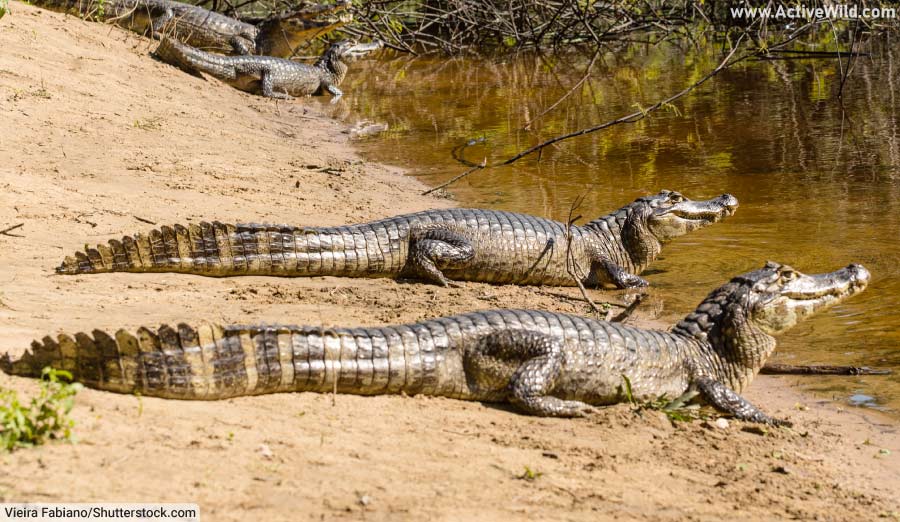

- Type of Animal: Reptile
- Family: Alligatoridae
- Where Found: South America, Central America, Mexico
Caimans are crocodilians belonging to the subfamily Caimaninae, which is part of the family Alligatoridae (which is also home to alligators).
There are six species of caiman. They range in size from the 1.4 m / 4.6 ft Cuvier's dwarf caiman to the 5 m / 16 ft-plus black caiman – the largest member of the alligator family. The spectacled caiman is the most common crocodilian.
Apart from the spectacled caiman, which is found as far north as Mexico, caimans are found only in South America, where they inhabit freshwater lakes, rivers and wetlands.
The teeth of caimans are longer and sharper than those of alligators.
Discover More With Active Wild
You can find out more about caimans on this page: Caiman Facts
You can find out more about the spectacled caiman on this page: Spectacled Caiman Facts
Capybara
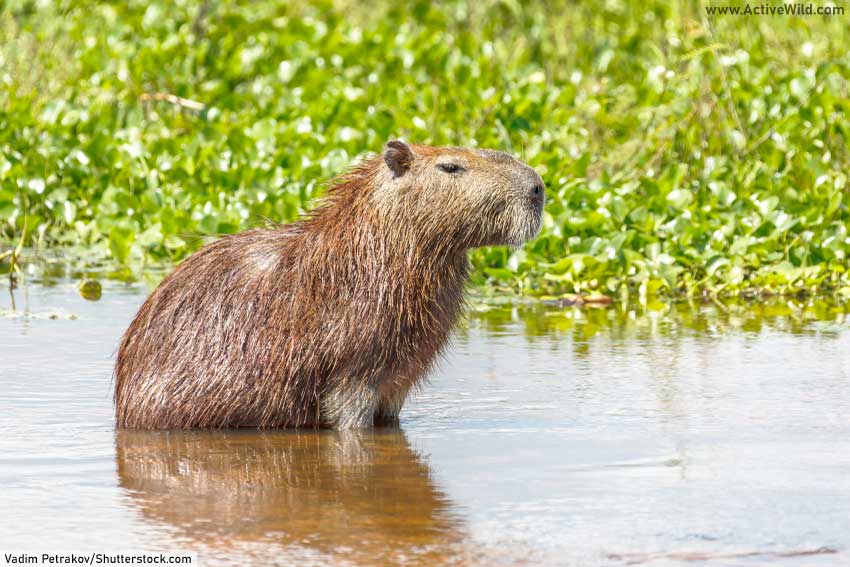

- Type of Animal: Mammal
- Family: Caviidae
- Where Found: South America
- Scientific Name: Hydrochoerus hydrochaeris
- Conservation Status: Least Concern
The capybara is the world’s largest rodent, growing to around the size of a Labrador retriever. This freshwater mammal is found throughout much of South America (all countries apart from Chile) and into Central America. Escapee capybaras have also been spotted in Florida.
The capybara is semiaquatic, and never found far from water. Its toes are slightly webbed for swimming, and it can stay underwater for up to five minutes.
Discover More With Active Wild
You can find out more about capybaras on this page: Capybara Facts
You can see more rainforest animals on this page: Rainforest Animals
Common Watersnake
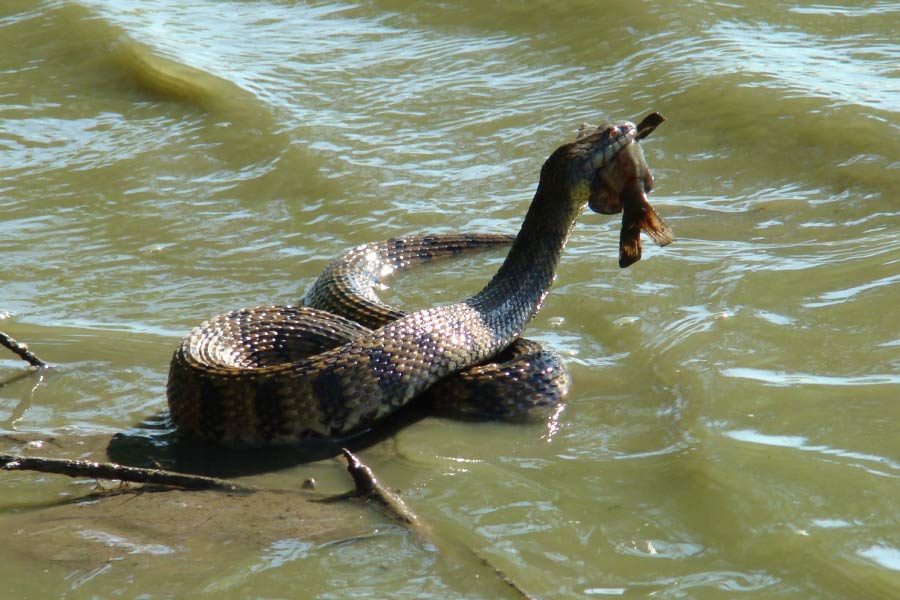

- Type of Animal: Reptile
- Family: Colubridae
- Where Found: North America
- Scientific Name: Nerodia sipedon
- Conservation Status: Least Concern
Found throughout the eastern United States and into east Canada, the common watersnake is found either in, or near to, a variety of freshwater bodies, including marshes, lakes and rivers.
Averaging around 75 cm / 2.46 ft in length, the common watersnake has an olive-brown body and darker brown stripes, and gets darker with age. It is occasionally mistaken for the cottonmouth, a highly-venomous viper.
The common watersnake is nonvenomous, and although capable of inflicting a painful bite, is not considered dangerous to humans.
The common watersnake hunts a variety of vertebrate and invertebrate prey, including fish, amphibians, small mammals and crustaceans.
Discover More With Active Wild
You can find out more about snakes on this page: Fun Facts on Snakes
Discover different types of snakes on this page: Types of Snakes
Crayfish
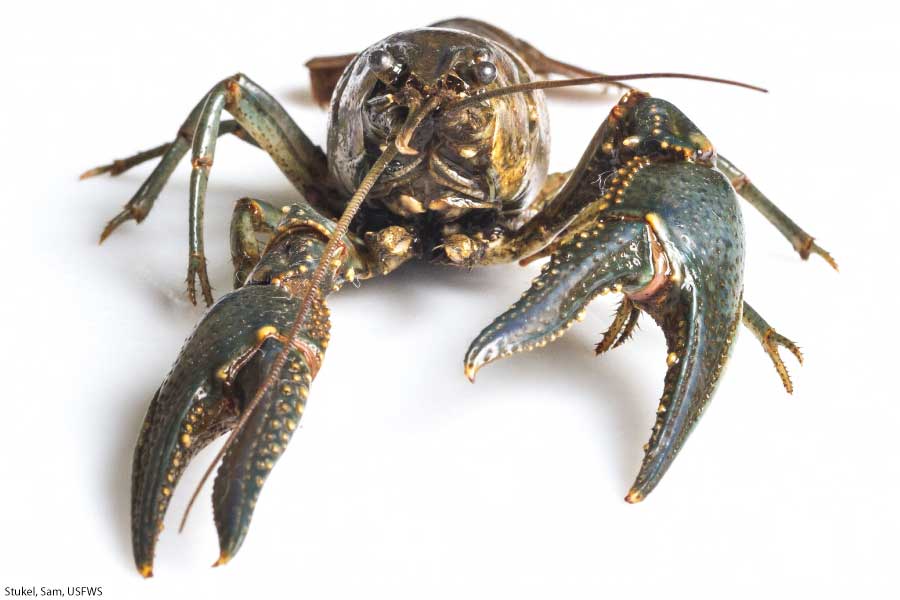

- Type of Animal: Crustacean
- Infraorder: Astacidea
- Where Found: All continents except Antarctica
Crayfish are freshwater crustaceans closely related to lobsters. In North America, crayfish are also known as crawdads and crawfish, and in Australia they are known as yabbies.
The bodies of crayfish comprise 20 segments, which are divided into two main parts: the cephalothorax, which includes the head, and the abdomen.
Crayfish have ten main legs for walking, and a number of additional appendages for eating, swimming and reproduction. The first pair of legs is equipped with large claws (the second and third pairs are also clawed).
Discover More With Active Wild
You can find out more about crustaceans on this page: Crustaceans - The Ultimate Guide
Dipper
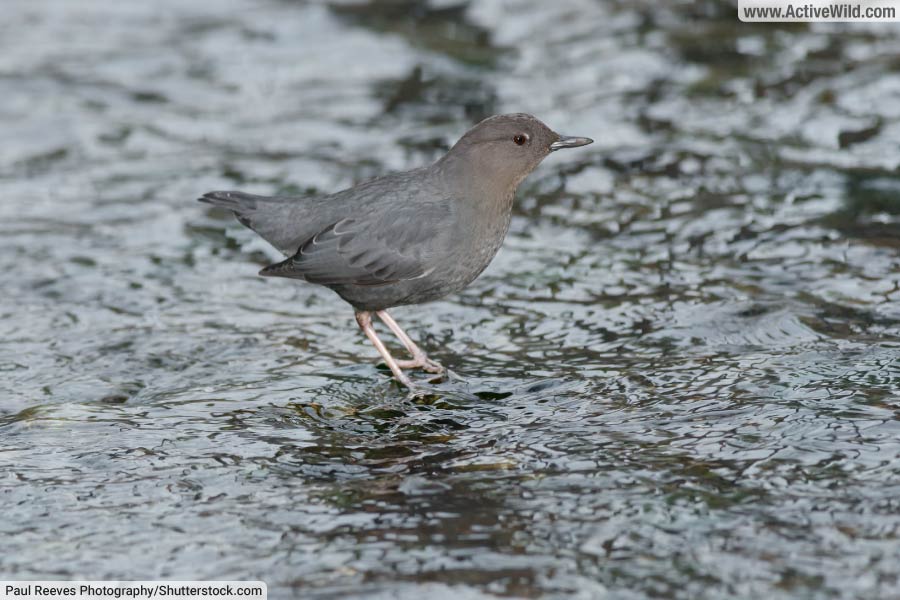

- Type of Animal: Bird
- Family: Cinclidae
- Genus: Cinclus
The five dipper species are the only passerines* able to dive and swim underwater. These little birds are a common sight by rivers and streams in many parts of the world, and can be recognized by the characteristic bobbing motion they make between dives.
Dippers are able to fly, but their short wings also function as flippers when the bird is underwater.
Each of the five species of dipper is found in a different part of the world. Dippers are present in the Americas, Europe, Asia, and the northern tip of Africa.
* Passerines are also known as perching birds, or songbirds. Their feet are adapted for perching, with three forward-pointing claws, and one backwards-pointing claw.
Discover More With Active Wild
Test your knowledge of birds with these Android apps: North American Birds ID Quiz App, British Birds Quiz App
Find out more about birds on this page: Birds - The Ultimate Guide
You can find out more about the different types of birds on this page: Types of Birds
Diving Beetle
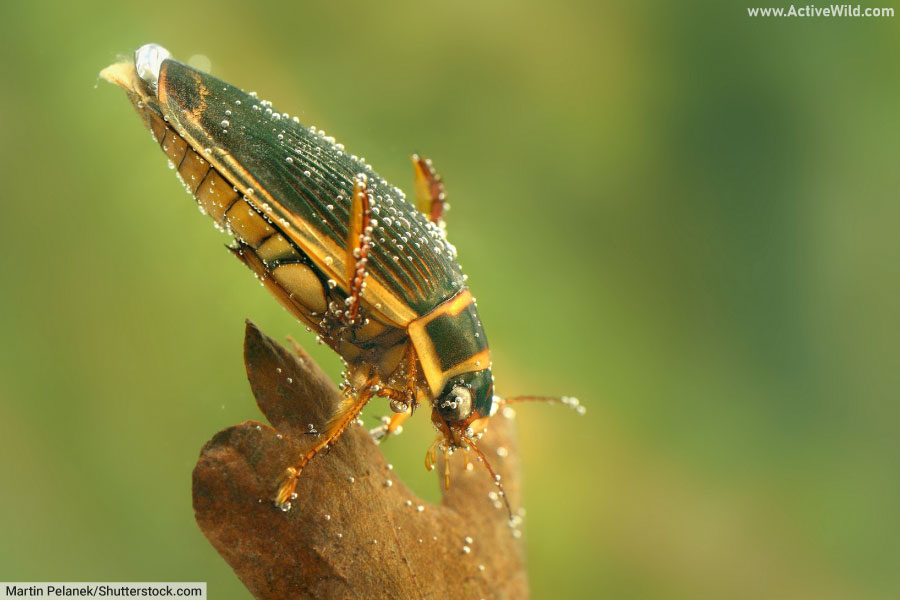

- Type of Animal: Insect
- Family: Dytiscidae
Diving beetles are a family of insects that spend most of their lives in the water, although adults are also able to fly.
These large freshwater insects are voracious predators, both in their larval and adult forms. Tadpoles are common prey, and even small fish can fall victim to the insects.
Adult diving beetles store a supply of air under their wing cases, and can be seen coming to the surface to replenish this supply.
Discover More With Active Wild
You can find out more about insects on this page: Insects - The Ultimate Guide
Find out more about beetles on this page: Beetles - A Complete Guide
Dragonfly
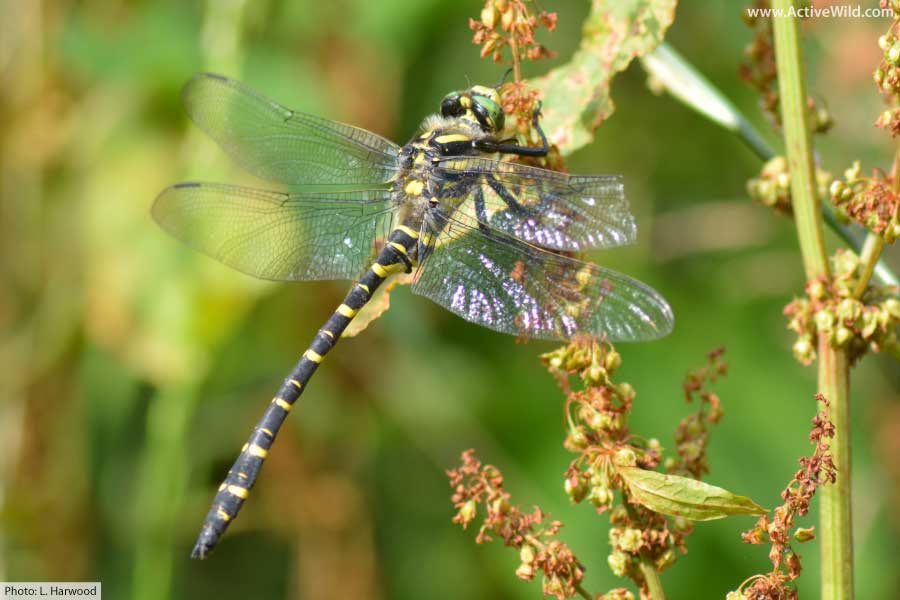

- Type of Animal: Insect
- Order: Odonata
- Infraorder: Anisoptera
- Where Found: Every continent except Antarctica
Dragonflies are large insects found in freshwater habitats in many parts of the world.
Together, the 3,000 or so species of dragonfly together make up the sub-order Anisoptera, which is part of the order Odonata.
A dragonfly spends most of its life underwater in its larval stage, which, in some species, can last up to five years. The larva – known as a nymph or naiad – climbs out of the water in order to metamorphosize into its adult form.
Depending on species, adult dragonflies live for between a few days to around 10 weeks.
Dragonflies are voracious predators in both their larval and adult forms. Dragonfly larvae prey on tadpoles and even small fish, while adult dragonflies hunt on the wing, grabbing smaller insects in mid-air and carrying them to a perch to eat.
Adult dragonflies are powerful fliers, capable of sudden direction changes, hovering, and even flying backwards.
Discover More With Active Wild
You can find out more about insects on this page: Insects - The Ultimate Guide
Electric Eel
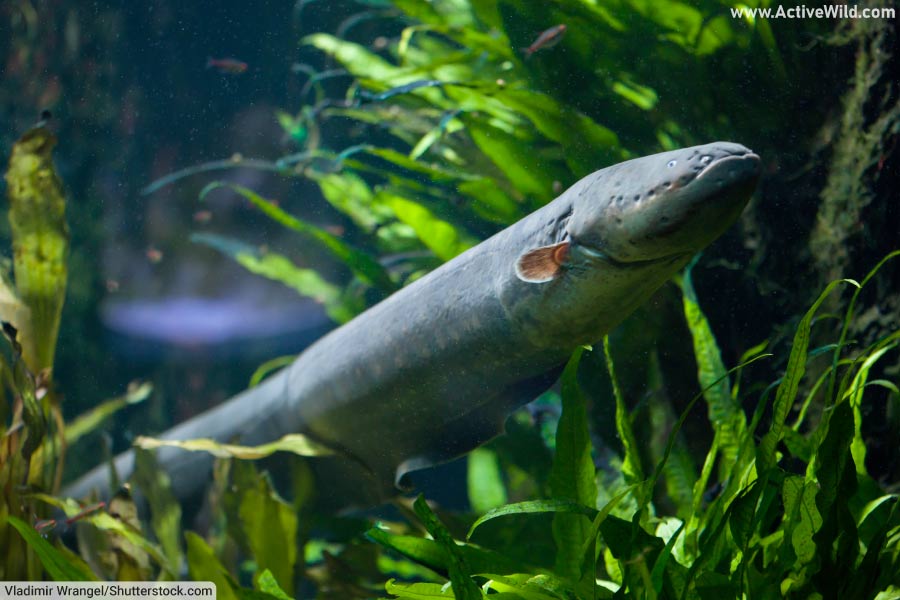

- Type of Animal: Fish
- Family: Gymnotidae
- Where Found: South America
- Scientific Name: Electrophorus electricus
- Conservation Status: Least Concern
The electric eel is a species of fish well-known for its ability to create a strong electrical charge.
Native to South America, the electric eel inhabits freshwater rivers and swamps. It grows to around 2 m / 6.56 ft. in length.
Despite its name, the electric eel is a knifefish, rather than a true eel. (Knifefish belong to the order Gymnotiformes, while true eels make up the order Anguilliformes.)
All knifefish are able to produce an electrical charge for navigating in dark, muddy water.
The electrical charge produced by the electric eel is strong enough to be used both for capturing prey and as a means of self-defense.
Although an electric shock from an electric eel is extremely painful, it is rarely fatal.
Discover More With Active Wild
You can find out more about the electric eel on this page: Electric Eel Facts
Discover more rainforest animals on this page: Rainforest Animals List with Pictures & Facts
Freshwater Crab
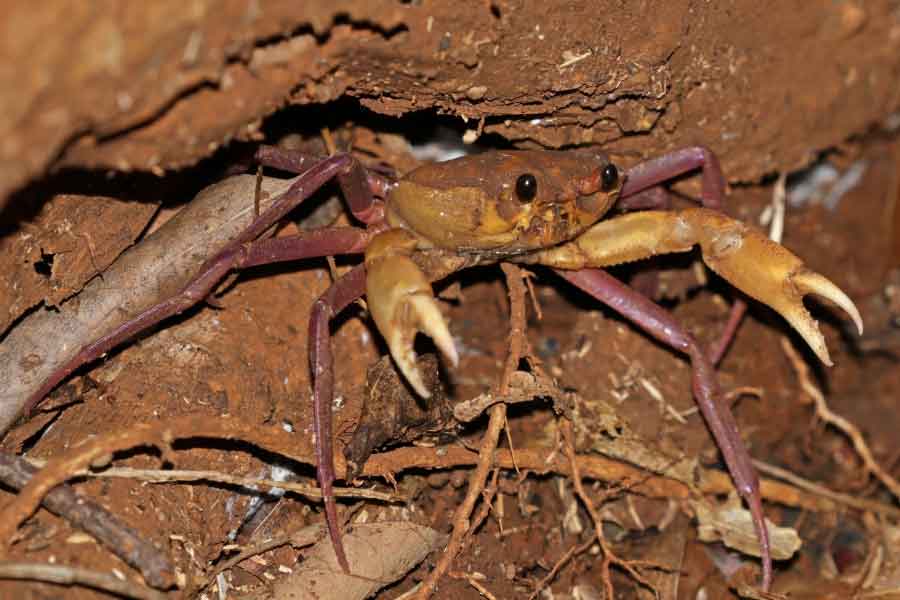

- Type of Animal: Crustacean
- Where Found: Tropical and subtropical regions worldwide
Crabs are a group of crustaceans mainly associated with marine habitats. However, around 1,300 of the almost 8,000 known crab species live in freshwater habitats.
Freshwater crabs are most common in tropical and subtropical regions, and are divided between eight families. As well as gills, which allow them to breathe underwear, some freshwater crabs have lung-like areas in their gill chambers that allow them to breathe air.
Unlike marine crabs, which produce large numbers of larvae, female freshwater crabs produce smaller numbers of offspring and are known to exhibit parental care.
Discover More With Active Wild
You can find out more about crustaceans on this page: Crustaceans - The Ultimate Guide
Freshwater Jellyfish
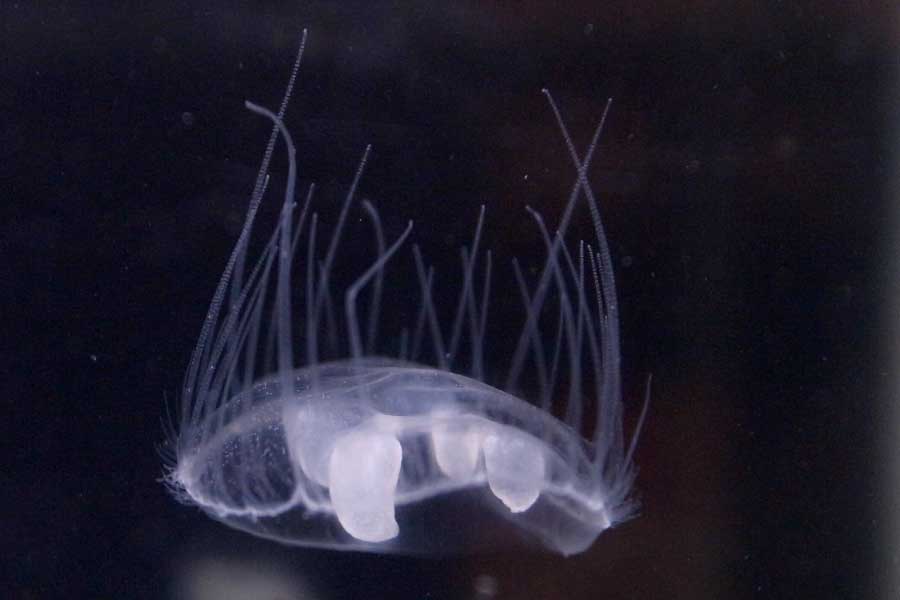

- Type of Animal: Cnidarian
- Family: Olindiidae
- Where Found: All continents except Antarctica
- Scientific Name: Craspedacusta Sowerbii
- Conservation Status: Unassessed
The majority of jellyfish are found in marine environments, but a number of jellyfish of class Hydrozoa are found in freshwater habitats.
One such hydrozoan is Craspedacusta Sowerbii, which is also known as the peach blossom jellyfish, or, simply, as the freshwater jellyfish.
Originally found in China, the freshwater jellyfish has been introduced to all continents except Antarctica, having been either transported with aquatic plants and fish, or carried by waterfowl.
The freshwater jellyfish is 5 to 25mm in diameter, and has between 50 and 500 tentacles.
Like all jellyfish, the tentacles of the freshwater jellyfish have stinging cells, however, those of the freshwater jellyfish are unable to pierce human skin and are therefore harmless to humans.
Discover More With Active Wild
You can find out more about different types of animals on this page: Types of Animals
Frog
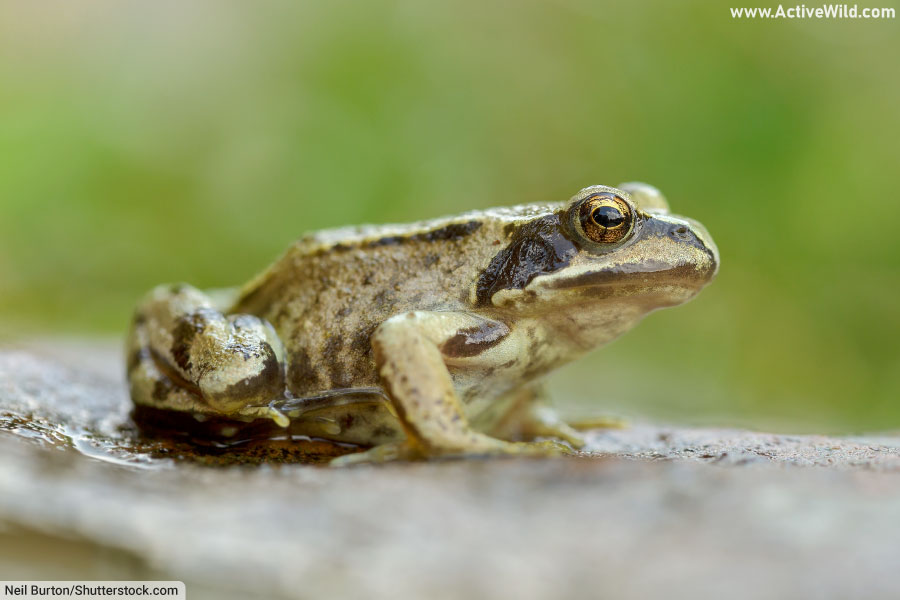

- Type of Animal: Amphibian
- Order: Anura
Frogs are small to medium-sized, predatory amphibians in the order Anura.
Frogs hatch from eggs, and spend the first stage of their life in an aquatic, larval stage known as a tadpole.
Tadpoles lack limbs, and propel themselves through the water with their long tails. They breathe with gills.
Frogs then undergo a physical change known as metamorphosis, in which they lose their gills and tails and develop lungs and limbs.
In their adult form, frogs can breathe air and venture onto land.
Discover More With Active Wild
You can find out more about amphibians on this page: Amphibians - The Ultimate Guide
See more amphibians on this page: List of Amphibians with Pictures & Facts
Giant Freshwater Stingray
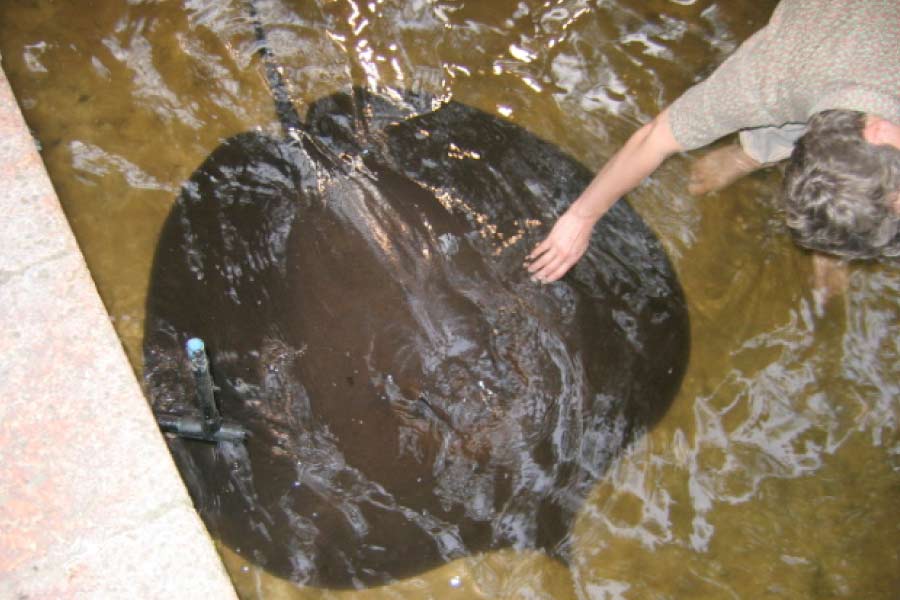

- Type of Animal: Fish
- Family: Dasyatidae
- Where Found: Asia
- Scientific Name: Urogymnus polylepis
- Conservation Status: Endangered
The giant freshwater stingray, also known as the giant freshwater whipray, is the world’s largest freshwater fish, growing to lengths of up to 16.4 ft. / 5 m, and widths of up to 7.2 ft. / 2.2 m.
The species is found in rivers and estuaries in Southeast Asia. It is one of around 220 species of stingray, which together make up the suborder Myliobatoidei.
Like other stingrays, the giant freshwater stingray’s tail is equipped with a stinger that can inflict serious wounds on humans.
Discover More With Active Wild
You can find out more about fish on this page: Fish - The Ultimate Guide
Discover interesting fish from all around the world: Types of Fish
Green Anaconda
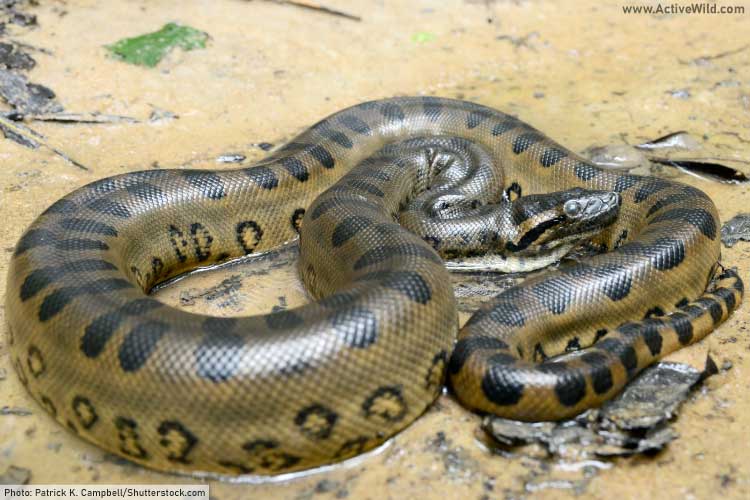

- Type of Animal: Reptile
- Family: Boidae
- Where Found: South America
- Scientific Name: Eunectes murinus
- Conservation Status: Least Concern
The green anaconda reaches lengths of 10 – 12 m / 32.8 – 39.4 feet, and weights of up to 250 kg / 551 lbs. The species is the world’s largest snake in terms of weight, but not in length (the reticulated python is even longer). Female anacondas are larger than males.
This fearsome apex predator is semiaquatic and found in freshwater lakes and rivers throughout much of northern and central South America.
The green anaconda is an excellent swimmer and ambushes its prey from the water. The snake will feed on almost anything it can catch, including deer, large rodents, fish, turtles, birds, and caimans.
Due to its slow metabolism, the green anaconda can go several months without food after a large meal.
Discover More With Active Wild
You can find out more about green anacondas on this page: Green Anaconda Facts
Discover more about the world of snakes: Snake Facts
You can see more amazing snakes on this page: Types of Snakes
Hellbender
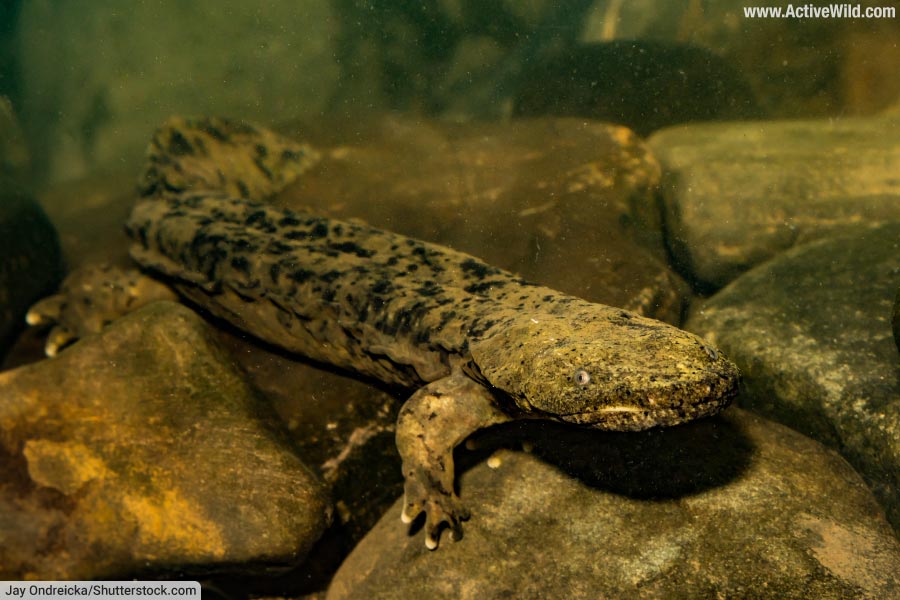

- Type of Animal: Amphibian
- Family: Cryptobranchidae
- Where Found: North America
- Scientific Name: Cryptobranchus alleganiensis
- Conservation Status: Vulnerable
Found under rocks in fast-flowing rivers and streams in the eastern United States is the hellbender, an amphibian distinguished both by its large size and by the wrinkled frills of skin running along the sides of its body.
This oversized amphibian belongs to the giant salamander family, Cryptobranchidae. It is one of four members of the family, the others being the Japanese, Chinese, and South China giant salamanders. (An additional, fifth species may also be present in China.)
The hellbender, despite being the smallest giant salamander, reaches a length of up to 74 cm / 29 in., and is the largest amphibian found in North America.
Unlike many amphibians, which can live away from water after undergoing metamorphosis into their adult forms, the hellbender remains fully aquatic, even after reaching adulthood.
The folds of skin that run along the sides of the amphibian’s body are able to absorb oxygen. The folds increase the animal’s surface area, thereby increasing its oxygen-absorbing ability.
Most of the oxygen the hellbender needs is absorbed from the water via its skin.
Discover More With Active Wild
You can find out more about the hellbender on this page: Hellbender Facts
Find out more about amphibians on this page: Amphibians - The Ultimate Guide
Heron
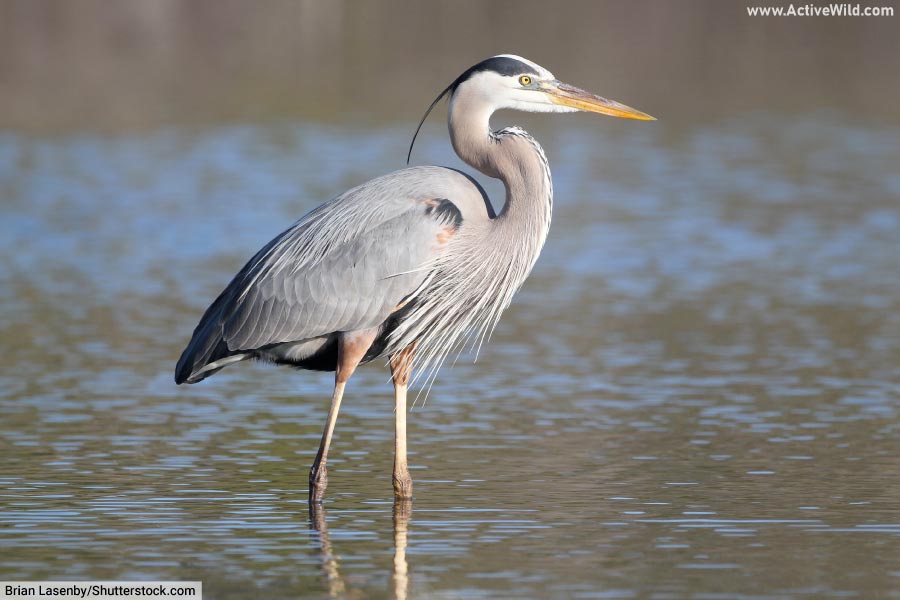

- Type of Animal: Bird
- Family: Ardeidae
Herons are predatory birds with long necks, long legs, and long, powerful bills. They typically hunt by standing motionless by the water’s edge, capturing passing prey with a swift lunge of their dagger-like bills.
Herons usually hunt aquatic prey such as fish and amphibians, but will also target mammals and reptiles.
One of the best-known herons of North America is the great blue heron. The grey heron is a common wetland bird in both Europe and Asia.
Although herons are usually seen in freshwater habitats, they may also be seen by the coast.
Together with egrets and bitterns, herons make up the family Ardeidae.
Discover More With Active Wild
Test your knowledge of birds with these Android apps: North American Birds ID Quiz App, British Birds Quiz App
Find out more about birds on this page: Birds - The Ultimate Guide
You can find out more about the different types of birds on this page: Types of Birds
Hippopotamus
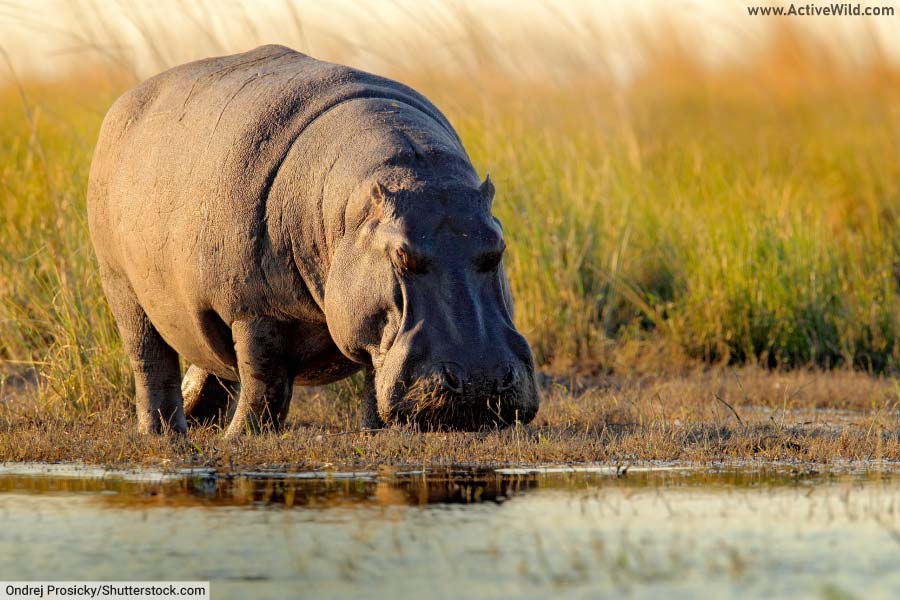

- Type of Animal: Mammal
- Family: Hippopotamidae
- Where Found: Africa
- Scientific Name: Hippopotamus amphibius
- Conservation Status: Vulnerable
Weighing between 1,300 and 1,500 kg / 2866.01 to 3306.93 lb., the common hippopotamus, or “hippo”, is the 6th heaviest land animal; only the three elephants and the white and Indian rhinos are heavier.
The only other living member of the hippopotamus family is the pygmy hippopotamous, which is found in the rainforests of West Africa.
The closest living relatives of the hippos are cetaceans – animals such as whales and dolphins.
The hippo lives a semi-aquatic lifestyle, spending most of the day in the water, and only emerging in the evening to feed. Although hippos are herbivores (plant-eaters), due to their size and aggressive nature they are among Africa’s most dangerous animals.
Discover More With Active Wild
You can find out more about the hippopotamus on this page: Hippo Facts
Discover more African animals on this page: African Animals List with Pictures & Facts
Kingfisher
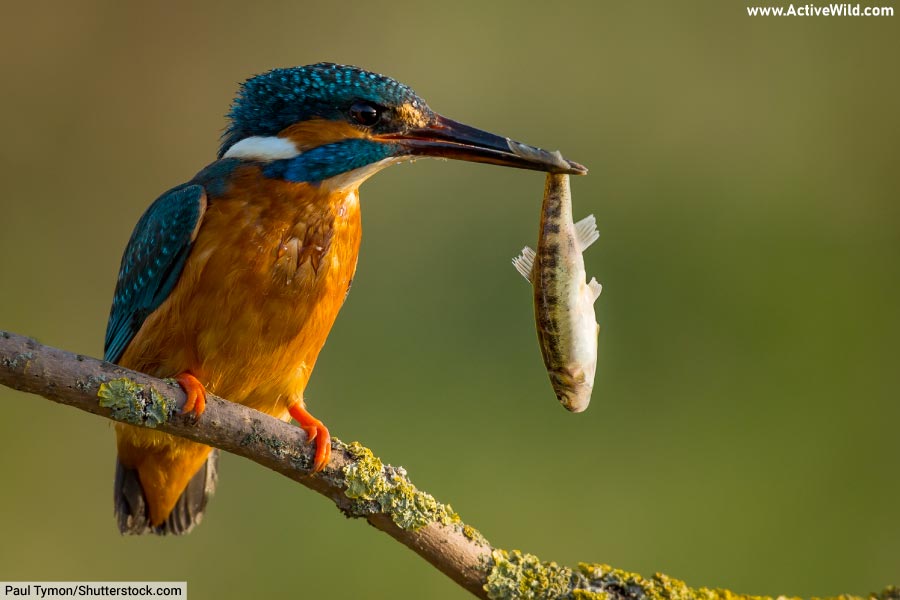

- Type of Animal: Bird
- Family: Alcedinidae
- Where Found: All continents except Antarctica
Kingfishers are a family of small to medium-sized birds with large heads, long, powerful bills, and, in many species, brightly-colored plumage.
Although the family Alcedinidae is known as the “kingfisher family”, many of its 115 or so members don’t live near water (and therefore, don’t eat fish!)
Most of the kingfishers that do live near water (and eat fish) belong to either the “River Kingfisher” or “Water Kingfisher” subfamilies. They typically dive into rivers and lakes from a perch, capturing their prey in their long bills.
Familiar kingfishers include the belted kingfisher, a water kingfisher found near bodies of freshwater in North America, and the common kingfisher (or, simply “kingfisher”), a river kingfisher found in Europe and North Africa.
Although both of the above species are usually found in freshwater habitats, they are occasionally also found in coastal habitats.
Discover More With Active Wild
Test your knowledge of birds with these Android apps: North American Birds ID Quiz App, British Birds Quiz App
Find out more about birds on this page: Birds - The Ultimate Guide
You can find out more about the different types of birds on this page: Types of Birds
Lake Trout
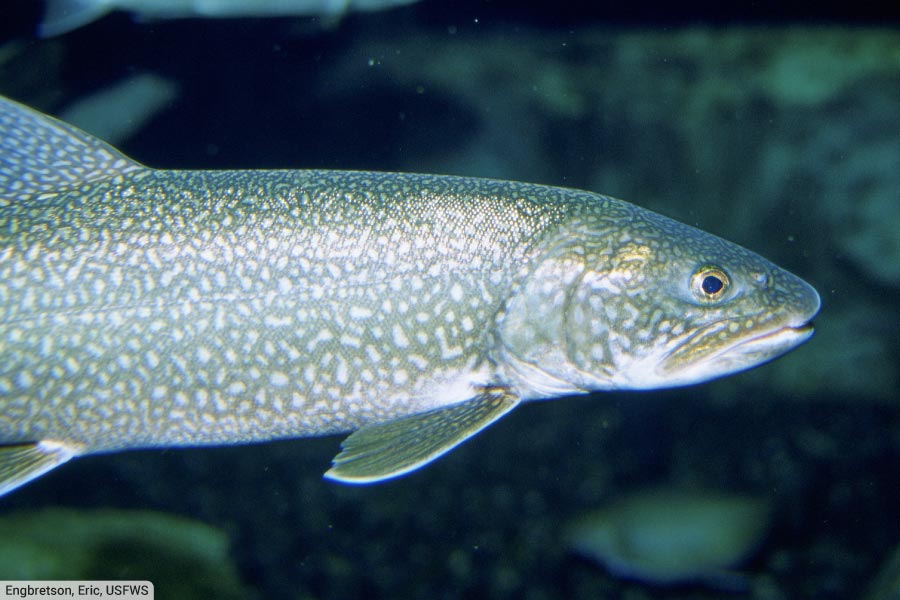

- Type of Animal: Fish
- Family: Salmonidae
- Where Found: North America
- Scientific Name: Salvelinus namaycush
- Conservation Status: Unassessed
The lake trout is a member of the trout and salmon family, Salmonidae, that is found in lakes in North America.
Despite its name, the lake trout is a char belonging to the genus Salvelinus, rather than a trout. (Trout belong to the genus Salmo, although some char are also known as trout.)
The lake trout inhabits cold, well-oxygenated water, and is found in all five of the Great Lakes. After reaching adulthood, its diet consists mainly of other freshwater fish, including ciscoes and sculpins.
Discover More With Active Wild
You can find out more about fish on this page: Fish - The Ultimate Guide
Discover interesting fish from all around the world: Types of Fish
Largemouth Bass
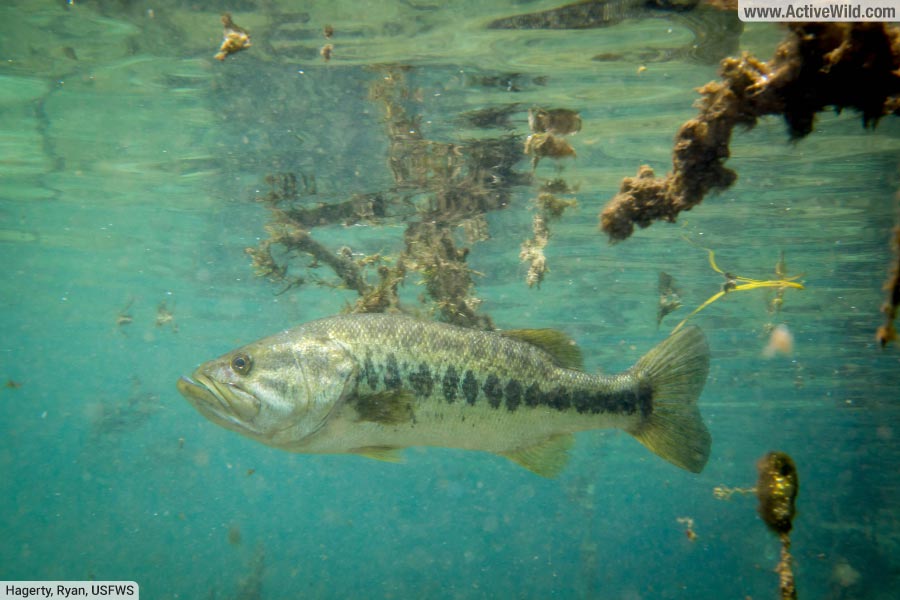

- Type of Animal: Fish
- Family: Centrarchidae
- Where Found: North America
- Scientific Name: Micropterus salmoides
- Conservation Status: Least Concern
The largemouth bass is a freshwater fish found in the United States, southern Canada and northern Mexico. It is the largest of the black basses, a group of freshwater fish that also includes the closely-related smallmouth bass.
The largemouth bass can be differentiated from its smallmouth cousin by its larger size, larger mouth (the upper jaw extends past the eye); green, rather than brown color; and the dark blotches on its sides, which are horizontal rather than vertical.
Both species are popular quarry for anglers.
The largemouth bass is usually around 16 in. in length, but the longest-known individual reached 38.2 in.
Discover More With Active Wild
You can find out more about fish on this page: Fish - The Ultimate Guide
Discover interesting fish from all around the world: Types of Fish
Mayfly
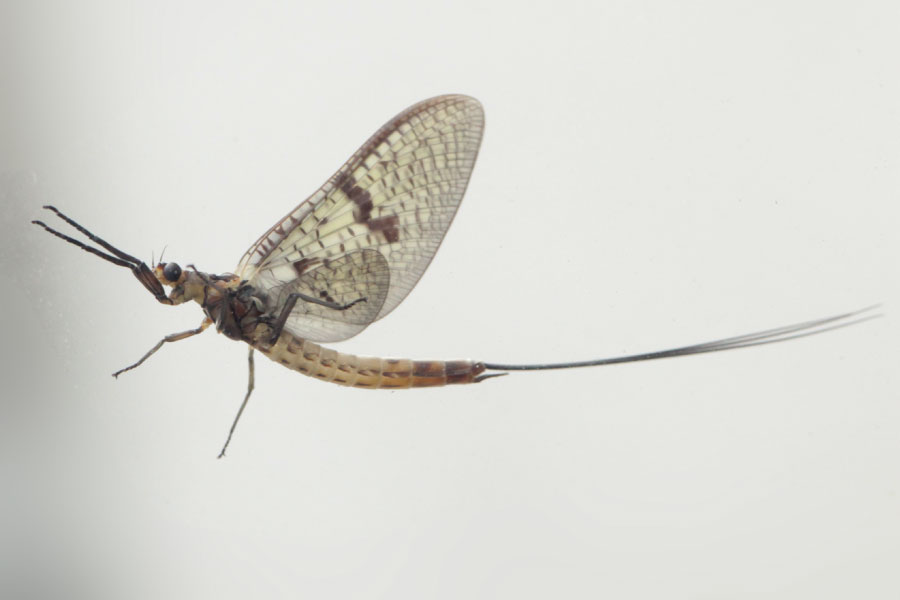

- Type of Animal: Insect
- Order: Ephemeroptera
- Where Found: Worldwide, except Antarctica
Mayflies are insects found in and around freshwater habitats in many parts of the world. As adults, mayflies have long bodies, and long, delicate wings that are held upright, rather than folded along the back.
A mayfly spends the majority of its life living underwater in a larval form known as a nymph or naiad. Depending on the species, this stage can last up to several years.
Eventually, the mayfly nymph undergoes its penultimate molt, emerging as a winged subadult. The mayfly is the only winged insect to have two winged stages.
The subadult mayfly, after having emerged from the water, then undergoes its final molt. In its final, adult stage, which lasts from just a few hours to a day, the mayfly breeds, and the females lay their eggs.
There are over 3,000 species of mayfly. Most mayfly nymphs require clean, unpolluted water, and their presence can be a signifier of a healthy ecosystem.
Discover More With Active Wild
You can find out more about insects on this page: Insects - The Ultimate Guide
Newt
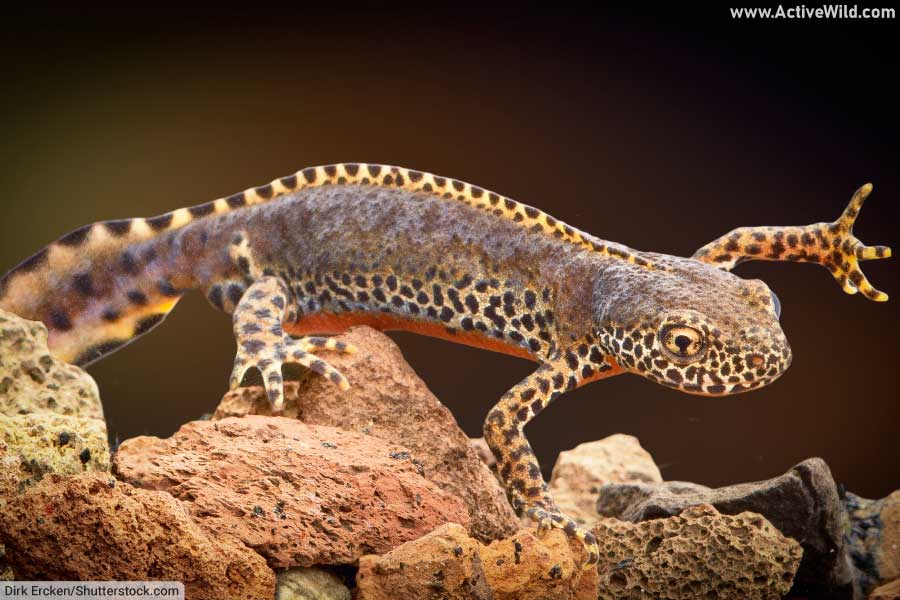

- Type of Animal: Amphibian
- Family: Salamandridae
- Subfamily: Pleurodelinae
Newts are amphibians in the subfamily Pleurodelinae, which is part of the salamander family. There are around 100 newt species (the Catalogue of life lists 105 species. Source https://www.catalogueoflife.org/data/taxon/K6F)
Like most amphibians, newts undergo metamorphosis, transforming from aquatic larvae with fins and gills into terrestrial adults with legs and lungs.
As adults, newts leave the water, with some species only returning each year to breed.
Discover More With Active Wild
Find out more about amphibians on this page: Amphibians - The Ultimate Guide
Northern Pike
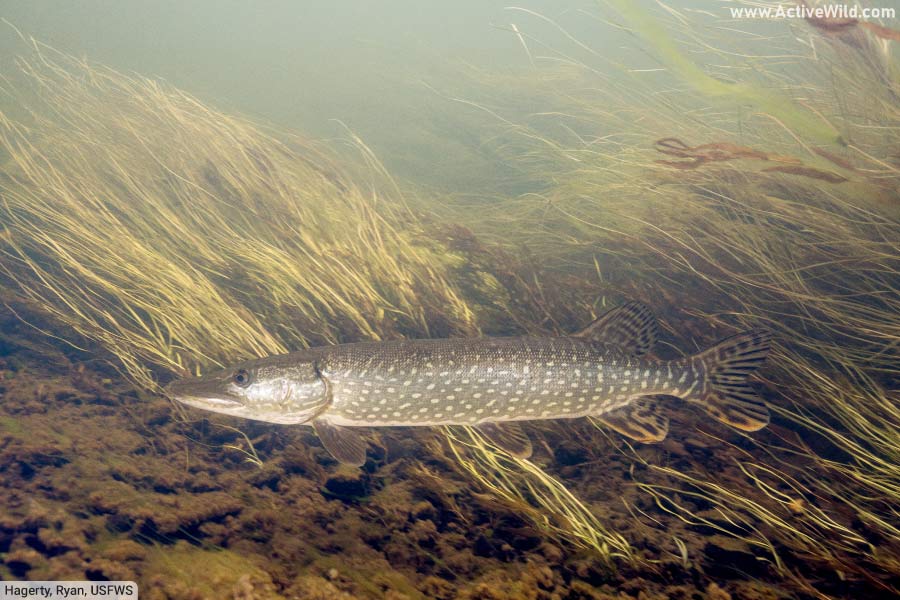

- Type of Animal: Fish
- Family: Esocidae
- Where Found: Northern hemisphere
- Scientific Name: Esox lucius
- Conservation Status: Least Concern
The northern pike, known simply as the pike in Britain and North America, is a large, predatory fish found in freshwater rivers, lakes and streams across much of the Northern Hemisphere.
The pike has a powerful, torpedo shaped body and a large mouth full of sharp teeth. Its olive-green body and pale green markings provide camouflage.
An ambush predator, the pike lies in wait for suitable prey to approach before launching a powerful, high speed attack, securing its victim in its backward-pointing teeth.
Discover More With Active Wild
You can find out more about fish on this page: Fish - The Ultimate Guide
Discover interesting fish from all around the world: Types of Fish
Otter
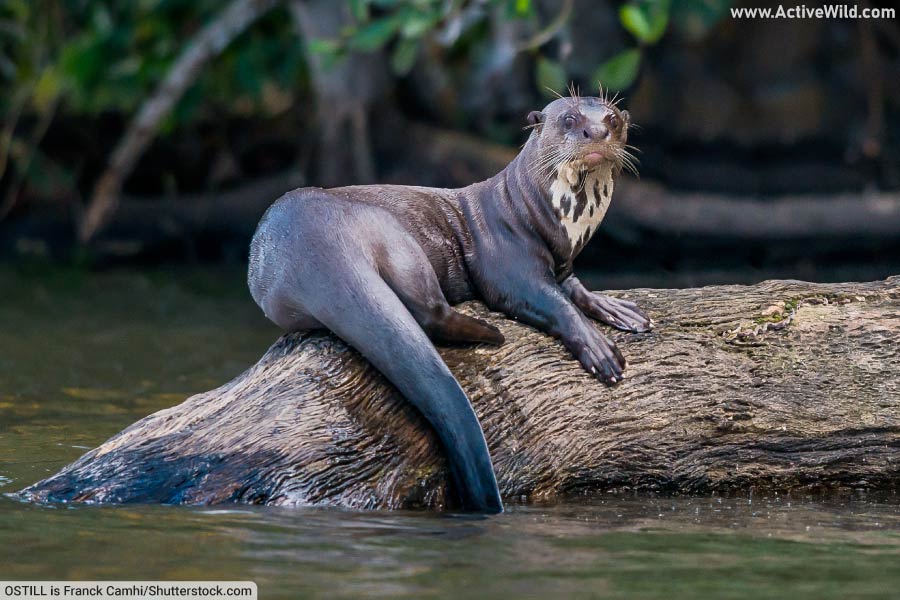

- Type of Animal: Mammal
- Family: Mustelidae
- Subfamily: Lutrinae
All but two of the 13 species of otter are found in freshwater habitats (the marine otter, found in South America, and the sea otter, found in cold northern waters, are both saltwater animals).
These aquatic carnivores belong to the subfamily Lutrinae, which is part of the weasel family, Mustelidae.
Otters have long bodies, short legs, and long tails. Adaptations for an aquatic lifestyle include webbed feet for swimming, the ability to hold their breath for extended periods of time, and ears and nostrils that can be closed when underwater.
Fish making up the bulk of the diet of most otter species.
Discover More With Active Wild
You can find out more about the giant otter on this page: Giant Otter Facts
Piranha
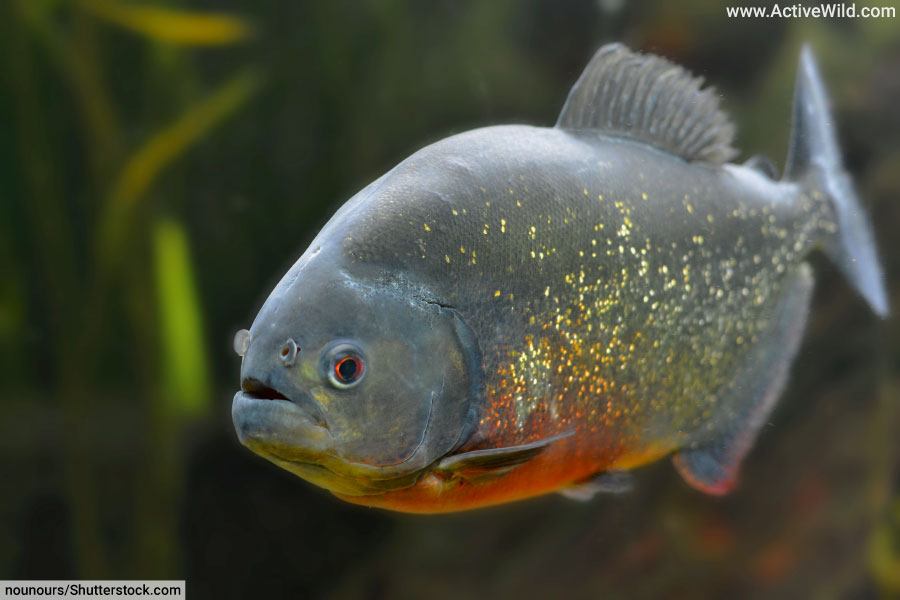

- Type of Animal: Fish
- Family: Serrasalmidae
- Where Found: South America
Piranhas are freshwater fish found in rivers and lakes in South America. Equipped with large teeth and powerful jaws, piranhas have a reputation as being fearsome predators. This is only partially true; most piranhas are omnivores, and are often themselves the prey of other freshwater animals such as caimans.
Piranhas will occasionally attack humans, but this usually results in nothing more than minor cuts to the hands or feet.
Discover More With Active Wild
You can find out more about piranhas on this page: Piranha Facts
You can find out more about fish on this page: Fish - The Ultimate Guide
Discover interesting fish from all around the world: Types of Fish
River Dolphin
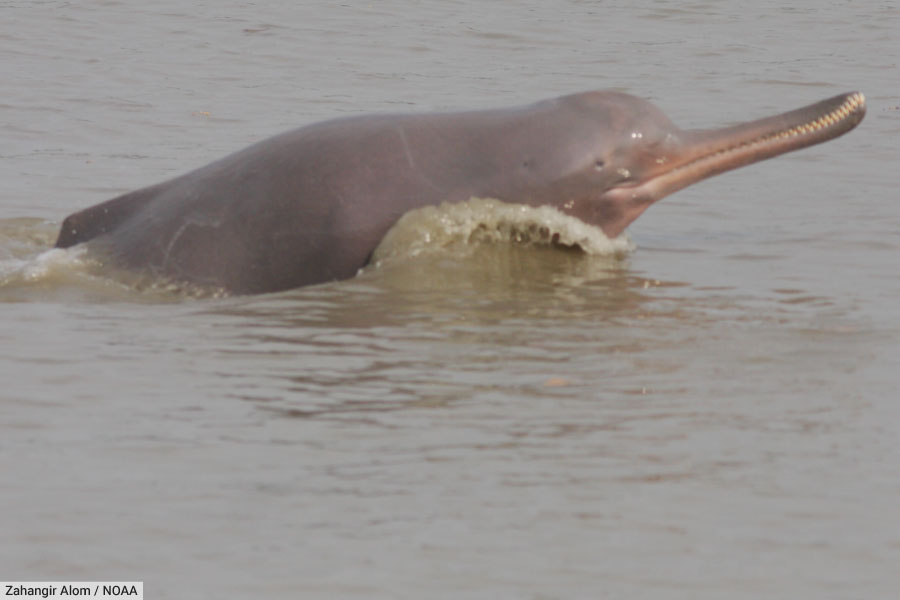

- Type of Animal: Mammal
- Family: Various
There are several different species of river dolphins (scientists disagree over exactly how many, as South American river dolphins are very similar to each another and may actually be subspecies of the same species).
River dolphins are found in both South America and Asia. Although these two groups are not closely related, all have similar characteristics, being smaller than their ocean counterparts, and highly-dependent upon echolocation for navigation and hunting.
River dolphins found in Asia are either blind, or have limited vision; good eyesight is not a requirement in the cloudy waters in which these freshwater mammals are found.
The Amazon river dolphin, found in South America, is the largest river dolphin. Unlike those of Asian cousins, its eyes are fully-functional.
Discover More With Active Wild
You can find out more about the Amazon river dolphin on this page: Amazon River Dolphin Facts
Discover more about dolphins on this page: Is A Dolphin A Mammal?
Turtle
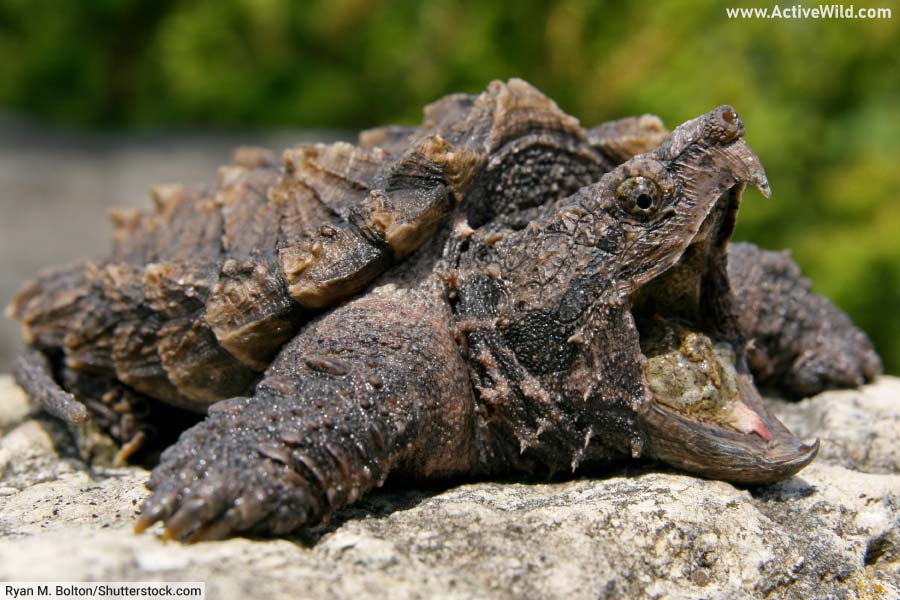

- Type of Animal: Reptile
- Order: Testudines
- Where Found: all continents except Antarctica
Turtles are reptiles belonging to the order Testudines, which is one of four reptilian orders, (the others being crocodilians, squamates (lizards and snakes), and the tuatara). Turtles are easily identified due to their hard, rounded shells and thick, leathery skin.
There are around 360 species of turtle, although not all are aquatic. Many terrestrial (land-living) turtles are often known as tortoises. Seven species of turtle are found in marine habitats, and are known as “sea turtles”.
The majority of turtles, however, are freshwater animals, found in or near bodies of water such as lakes and slow-moving rivers.
Many small, freshwater turtles are known as terrapins. Snapping turtles are a family (Chelydridae) of freshwater turtles known for the strength of their jaws.
Discover More With Active Wild
Discover many different types of turtle on this page: Types Of Turtles
You can find out more about the alligator snapping turtle on this page: Alligator Snapping Turtle Facts
Water Boatman
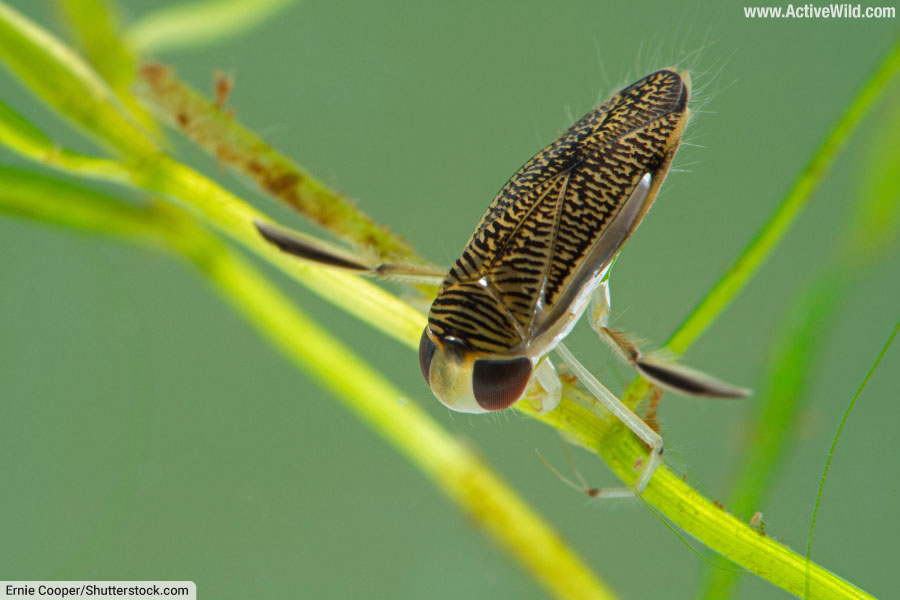

- Type of Animal: Insect
- Family: Corixidae
There are between 400 and 500 known species of water boatmen (the Catalogue of Life lists 402 species). (Source) https://www.catalogueoflife.org/data/taxon/8KK
These insects are found in freshwater habitats all around the world (a number of species in the family are found in saltwater habitats). They have flat bodies, and long, oar-like legs for propelling themselves through the water.
Most water boatmen are largely herbivorous, feeding on water plants and algae. They spend most of their time at the bottom, coming to the surface occasionally for air.
Discover More With Active Wild
You can find out more about insects on this page: Insects - The Ultimate Guide
Water Strider / Pond Skater
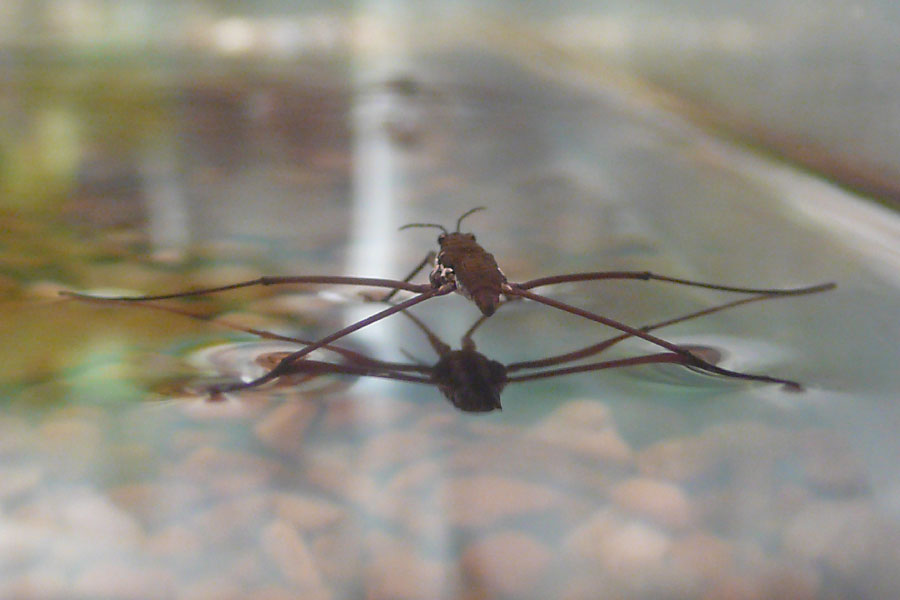

- Type of Animal: Insect
- Family: Gerridae
Water striders are a family of insects also known as pond skaters, water skeeters, and water bugs. Around 90% of the water striders are found in freshwater habitats; the remainder are found in saltwater environments.
Water striders have evolved the ability to walk on the water, their long, water-repelling legs preventing them from breaking the water’s surface tension. (The legs are covered in tiny hairs that capture air.)
An animal that lives on the surface of the water–such as a water strider–is known as a neuston.
Discover More With Active Wild
You can find out more about insects on this page: Insects - The Ultimate Guide
Water Vole
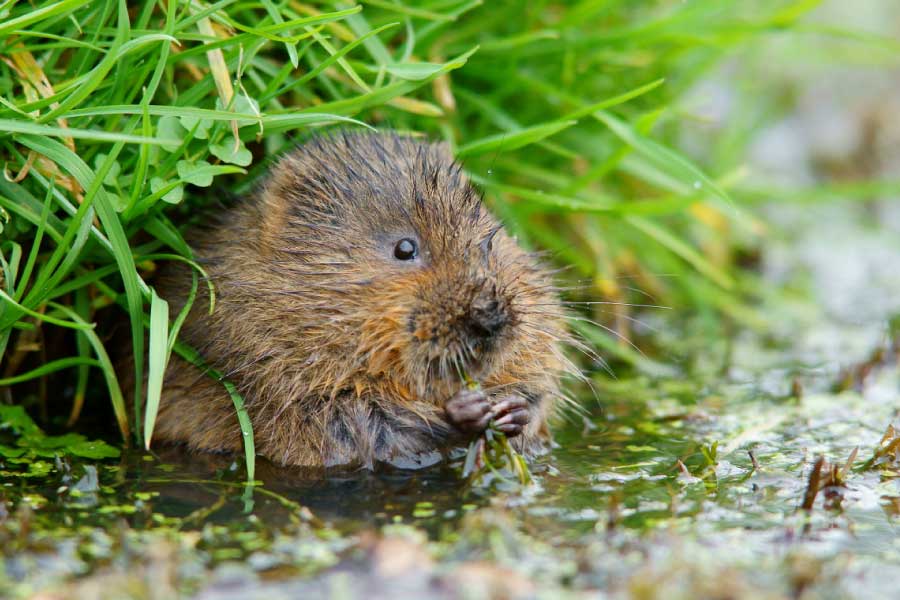

- Type of Animal: Mammal
- Family: Cricetidae
Several rodents are known as “water voles”, with two of the best-known being the American water vole and the European water vole.
Both belong to the family Cricetidae, which, with 608 recognized species, is the second-largest mammal family. (Other members of this family include hamsters, lemmings, and New World rats and mice.)
The American water vole is found in the northwestern United States and southwestern Canada. One of the largest North American voles, it is between 7 and 10 inches in length, and has large hind feet for swimming.
The European water vole is between 14 and 22 cm in length, and has a rat-like appearance (the species is also known as a “water rat”), although its nose is blunter than that of a brown rat, and its fur is chestnut-brown, rather than grey-brown, in color.
Both of these water voles have a global conservation status of “Least Concern”, although the population of European water voles in the UK has shrunk by up to 95% since the 1960’s.
Discover More With Active Wild
You can find out more about the different types of mammals on this page: Types of Mammals
Discover More With Active Wild
Ocean Animals Pictures & Facts
Rainforest Animals Pictures & Facts
Taiga Animals Pictures & Facts
Forest Animals Pictures & Facts

